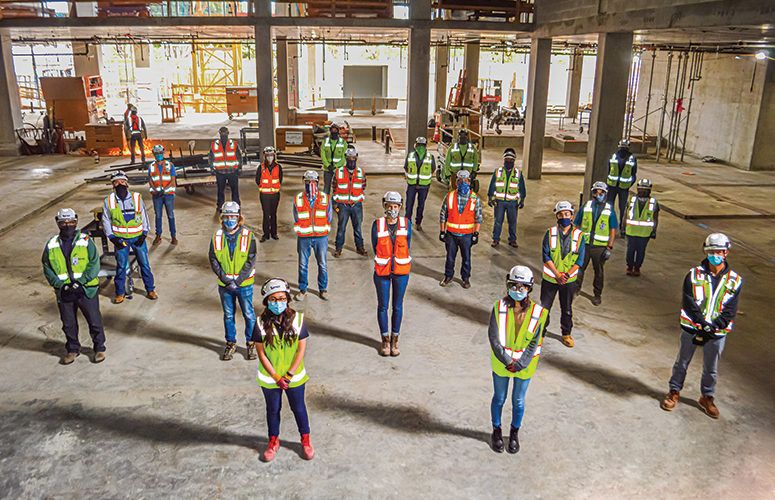
Institutional Construction Concerns
How builders are delivering social distancing solutions in a surprisingly busy institutional real estate market.
By Meg Fry, Contributing Writer On Nov 14, 2020With COVID-19 being more of a threat to spread indoors, one might consider the effect the pandemic has had on institutional construction, or the creation of buildings for the masses, such as schools, government buildings, healthcare facilities, and more.
However, the market is surprisingly meeting its yearly projections.
“Outside of the blips in March and April, projects that already were ongoing have progressed normally,” says Christopher Cornick, director of business development in New Jersey for Gilbane Building Co., one of the largest family-owned construction and real estate development firms in the industry.
In fact, some firms are busier than ever. Take DMR Architects, a top architectural and professional planning firm in Hasbrouck Heights that is still growing in both revenue and employees this year.
“We have about $1 billion in the pipeline of projects in design or under construction and that hasn’t really changed,” Lloyd Rosenberg, president and CEO of DMR Architects, says. “For example, we have half a dozen schools under construction, including in Carteret, Paterson and Plainfield, and we’re planning a new school in New Brunswick. Additionally, the amount of work being planned is remarkably good.”
Construction of essential facilities, such as those in healthcare, also help balance slower paces of development in other sectors, says John White Jr., regional chief operating officer at Structure Tone, a global construction management and general contracting firm with offices in Woodbridge.
“Healthcare was booming before the COVID-19 crisis and is still the most active,” White says. “Before COVID-19, we had worked with Atlantic Health System on more than 60 projects – then, throughout the most intense days of the pandemic, we worked on several emergency response projects while also continuing on some projects that already were set in motion.”
Urgent projects included installing more than 100 temporary negative air systems into existing windows to add to hospitals’ capacities to treat COVID-19 patients, White adds.
Meanwhile, Turner Construction, an international construction services company with offices in Somerset, was busy constructing a new field hospital, adding nearly 4,000 beds for the U.S. Army Corps of Engineers at Stony Brook University in response to COVID-19.
“We also saw very little slowdown in the work we did in New Jersey, thanks in part to all of our precautions,” says Mark Romanski, vice president and general manager at Turner Construction.
In an industry already familiar and comfortable with safety protocols and personal protective equipment, the added measures of masks, gloves, temperature screenings, and disinfectants were not a shock to the system.
“However, this situation did force project teams to become more comfortable with virtual collaboration, which allowed us to move projects forward even during the shutdown,” White says. “For example, we used virtual walk-through tools to capture progress on-site for our clients and design partners, who often were not physically coming to the site.”
Cornick said his team also applied existing cutting-edge technology to encourage and enhance safety measures against COVID-19.
“We’ve studied – and have discussed with our clients and design partners – what buildings will look like post-pandemic, and there are certainly things people are planning for today, particularly in regard to air filtration and HVAC systems, that COVID-19 has pushed further along,” Romanski says. “Additionally, and particularly in healthcare, clients are asking if there are things they can do for a bit more money that would give them more adaptability and flexibility to make adjustments in the event of a future pandemic, without needing to start from scratch or make any major structural changes.”
Current industry work includes modifying existing spaces to accommodate for COVID-19 protection, including installing plexiglass at areas of interaction, transitioning two-way doors into single entryways and exits, and installing touchless fixtures, to name a few.
“The modifications being made to these facilities allow people to have peace of mind while following best practices,” Cornick says. “For example, we are working with Bergen County right now on a reopening plan that would safely allow their employees and their constituents to return to these physical spaces and facilities, such as court houses and administrative buildings.”
However, whether clients are being proactive against future pandemics heavily depends on their policies and financial abilities, he added.
“Clients who already are and have been considering their employees’ health and wellbeing at work are certainly considering more WELL Building Certifications and making the appropriate accommodations to be better prepared if something like this should ever happen again,” Cornick says. “But some more reactive folks don’t want to, or can’t make, any capital decisions based solely on COVID-19. [They] are going to continue to do what they typically would from a brick-and-mortar standpoint, while addressing any government mandates or socially responsible accommodations with measures such as a reduction in office capacities.”
“What’s next for any institution with a large capital plan still seems underdetermined in these continued uncertain circumstances,” White says. “That said, as we look ahead, many healthcare institutions, for example, are anxious for people to get back to booking elective surgeries and other revenue-generating procedures, so we expect more projects to ecmerge once the threat of continued surges is behind us.”
Still, many building owners are beginning to analyze future projects in terms of funding and square footage, Cornick says, given the fact that remote work has become more necessary – and more viable – during COVID-19.
“Will they still need that much physical space?” he says. “It depends on who you talk to – which is why I think we may realize more of an impact from this in 2021 into 2022.”
Romanski agrees. “One day, a designer told us buildings will be smaller because more folks are now working from home, and the next day, a client called and said they wanted even more square footage to better allow for social distancing,” he says.
Rosenberg says that while the public buildings his firm is currently constructing and planning for are all working to accommodate on-site employees, it is still too soon to tell how people will react.
“We’re still going through the transition – and most people don’t want to spend a tremendous amount of money now for solutions to the unknown.”
The Raw Materials Factor
The speed at which buildings are constructed is being impacted by natural disasters.
While many industry players say they experienced only minor inconsistencies in the supply chain during the height of the COVID-19 pandemic, Christopher Cornick, director of business development in New Jersey for Gilbane Building Co., says 2020 proved why firms like his should always be brought on early in the design process.
“At the height of COVID-19, we had to shut down some project sites due to government mandates, but when we returned, the virus had already spread to other geographies and began impacting, for example, commercial furniture manufacturing in Michigan,” Cornick says. “We’re also continuing to see impacts on traditional building commodities like drywall and lumber as a result of a combination of COVID-19, the storms in the Gulf, and the fires in the West – and that doesn’t even account for all the materials coming in from overseas.”
If items used to take 14 weeks to receive, manufacturers are now extending those delivery dates to 20 weeks and charging premiums to expedite, Cornick adds.
“But if an architect is creating specifications, and we are also at the table, we can help guide our clients in those decisions,” he explains. “We could say, ‘Hey, what you chose is coming from location X, and there could be some impact to our schedule and your costs because of that.’
“We could then present them with more local, more readily available, and more cost-effective options, because it’s tough to make up the time when construction has already begun,” Cornick concludes.
To access more business news, visit NJB News Now.
Related Articles:





